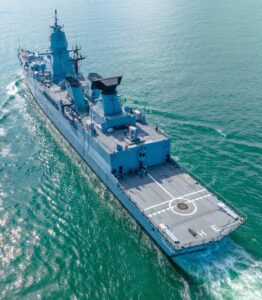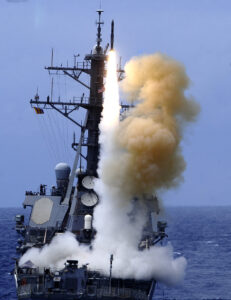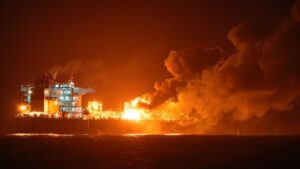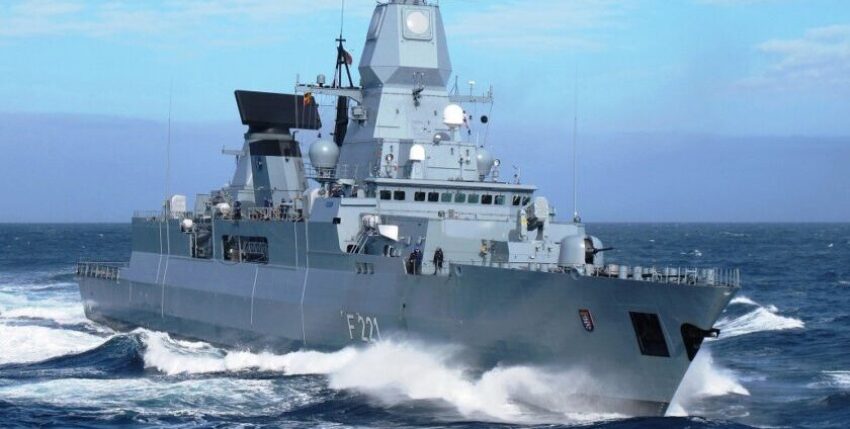The German frigate "Hessen" is on its way home to Wilhelmshaven. She has completed her deployment in the EU-led Operation ASPIDES to protect civilian shipping in the Red Sea and Gulf of Aden, a sea area threatened by drone and missile attacks, without suffering any serious damage. Until the redemptive "Air Warning White" after passing the Suez Canal northwestwards, banal said the withdrawal of the integrated air defence combat readiness of the frigate, it was - including the breaks for resupply and ammunition replenishment in Djibouti - a good 56 days in the area of operations.

"At home", high and dry, we were inundated with questions about threats, weapons deployment and ammunition: Well, we may be experts who also know how missiles are used, but we weren't there. We may be journalists, but we are also comrades who prefer to show more understanding for the crew than for excited sensationalism. We don't tell everything we know. And certainly not speculation. We all have no right to judge the mission and the performance of the crew, that is a matter for those responsible in the defence department. We can only express our respect for what the "Hessen" crew did under high public pressure and in the face of a direct, possibly deadly threat.

Not everything went smoothly, we know that. No reason to gloat about it. And when it comes to the question of what all this has cost the taxpayer and whether German shipowners should contribute to the costs, we have - to be honest - only one slightly annoyed counter-question: what does it cost the taxpayer if we put up with terrorism and do nothing? It's not about full shelves or supply chains, it's about free trade and protecting human life at sea.
And the fact that this mission has shown the limits of Germany's - and indeed the entire European Union's - defence capabilities has hopefully been understood. It was probably necessary to use force to emphasise the need to strengthen the Bundeswehr. Fortunately, no German forces were injured.
A dignified summary cannot and should not be drawn here, as it will take some time for the navy to come to terms with and "digest" this deployment at sea, the first since the Second World War, in terms of security policy. Will the population of the Federal Republic of Germany in its cross-section and in the present day ever realise what was achieved there? Apart from the families and friends of the crew members directly affected and the supporters in the command centres, who witnessed the events quite closely! Where should this be pointed out if not here - and in due course?

Reporting on the Red Sea and the Gulf of Aden
However, what would now be permissible and absolutely necessary, also to provide a background for assessment, is a summing up of the Red Sea and Gulf of Aden theatre of operations over the last six months. A review of the human, technical and material burden on the nations, navies and crews involved in the form of a few figures. After all, it will be very difficult for us to grasp or even experience the totality of the personal burdens, the logistical and maintenance challenges and the financial expenditure.
The US Navy was involved from the very beginning. It bore the main burden - more than that: it led an estimated 90% of the combat operations! We must also keep this categorisation in mind when we in Europe, with the happy return of our own units and despite various "misfires", cautiously slap our shoulders in relief! Even if Great Britain was there with HMS Diamond and fighter aircraft, the same applies here: first in - first out. Without wanting to name ships and dwell times in detail: France, Spain and Italy were also in the sea area early on with individual units. Until the European Union was able to agree on a joint operation, which fortunately happened quite quickly.

And however long the short European deployments last - the five rotating Arleigh Burke destroyers of the US Navy are in continuous operation there! They are the brave "workhorses" of the US Navy. USS Laboon, Carney and Mason each had to fend off dozens of direct attacks.
The American news portal "Military Times", registered in Arlington, Virginia, is a constant companion of events in the theatre of operations. Based on public sources and communications from US CENTCOM/Bahrain, daily reports were kept on what enemy weapons from the Houthi militias were deployed from positions in Yemen by sea, repelled or destroyed on land by air strikes - and which ships had suffered damage to material, cargo or personnel.
Summary
From the chronological outline from October 2023 to mid-April 2024 (see article "List of all incidents" from 22 April 2024) results in the The roughly calculated total gives a truly frightening picture, because all figures are minimum figures (the figures are probably 10 to 20% higher):
On the part of the Houthi militias at least "consumed" were:
230 combat drones, 265 missiles, 11 surface and 3 underwater drones, 3 air defence positions, various quantities of ammunition in partly underground weapons depots.
Over 270 weapons have been killed by the Huthi militias by sea against merchant ships and warships have been used. One about the same number of weapons could before their use by US forces (US Air Force) destroyed on Yemeni soil become.
In detail:
On Merchant ships were fired: 8 slow-flying combat drones, 14 low-flying cruise missiles/anti-ship missiles, 34 high-flying ballistic anti-ship missiles. 32 merchant ships were directly attacked and damaged - one was sunk. First casualties on board in early March.
On Warships were fired: 170 combat drones, 30 cruise missiles, 12 ballistic missiles, 3 surface drones, 1 underwater drone. Warships have been directly targeted more than 90 times - none have been damaged as of 17 April 2024.
On Yemeni soil destroyed were (since 15.01.2024): 50 combat drones, 170 cruise missiles, 2 ballistic missiles, 8 surface drones, 2 underwater drones, 3 air defence missile sites, 1 ground station, 6 weapons depots.
Valuation

The damage caused by the weapons used by the Houthi militias - with the exception of merchant ships - is extremely low. However, the material and financial cost of defence is enormous, considering that up to two missiles and other weapons can be deployed on each approaching weapon for safe defence. According to the portal "The War Zone", American destroyers had already deployed over 100 Standard Missiles (SM-2, SM-6) by mid-February - at a cost of USD 4 million each! Until Mid April the US Navy assumes costs in the amount of one billion dollars that would have to be invested to replace the spent missiles. These figures can be correlated and are therefore entirely plausible.
With the decline in the intensity of attacks observed since the beginning of April, it is assumed that the Houthi militias are beginning to run out of weapons. It is now extremely important to consistently cut off Iranian supplies to the militias in the western Yemeni regions.
Defence against attacks at sea is an extremely costly and at times high-intensity attrition scenario. Apart from a negotiated solution for the entire Middle East region, the protection of merchant ships by warships can probably only be achieved in the long term through a parallel and decisive fight against offensive weapons on land.
As long as the Middle East region is unable to find peace, this issue will remain with us.
ajs, hsc










